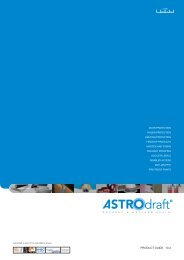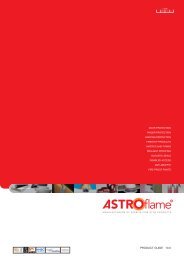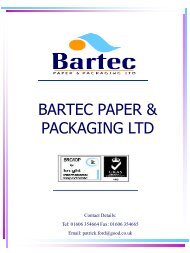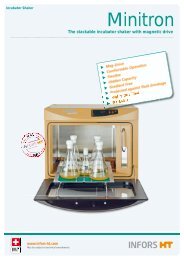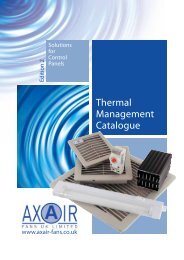Fastening & Assembly Solutions & Technology July 2012
Fastening & Assembly Solutions & Technology July 2012
Fastening & Assembly Solutions & Technology July 2012
You also want an ePaper? Increase the reach of your titles
YUMPU automatically turns print PDFs into web optimized ePapers that Google loves.
FAST JULY <strong>2012</strong><br />
ENGINE SEALANTS<br />
Ford extols the virtues<br />
of liquid gasketing<br />
Automotive engine design is dictating lighter engine blocks with thinner walls which presents an<br />
interesting challenge for the sealant supplier<br />
Oil pan joint on a Volvo S16 engine using<br />
Loctite 5900 silicone<br />
The Ford one litre Fox engine has<br />
received instant acclaim and will<br />
soon be manufactured across the globe.<br />
Designed at Ford’s Dagenham Diesel<br />
Centre (DDC), it has the highest output<br />
per displacement of any high rate production<br />
engine on the market with a power<br />
output of 125 ps. This radical and revolutionary<br />
engine will be standard in the<br />
Ford Focus and many other future models<br />
and includes a lot of technological<br />
improvements including the use of<br />
Loctite 5900 room temperature vulcanising<br />
(RTV) silicone for sealing the highly<br />
stressed joints.<br />
Tsunou Chang, Ford’s Liquid Sealing<br />
Specialist explained: “The Ford design<br />
rules dictate that the walls of an engine<br />
block should be a certain thickness. But<br />
progress comes out of challenging those<br />
design rules and our designers had proved<br />
in studies that half the wall thickness was<br />
do-able. But that meant the RTV process<br />
had to hold the engine with half the wall<br />
thickness and that presented Henkel with<br />
a challenge.”<br />
36<br />
This engine is small and highly<br />
stressed, four times that of a standard<br />
engine. This is a common<br />
trend and one to which Henkel<br />
gasketing products have responded.<br />
To meet the need for a more<br />
flexible product to accommodate<br />
the increased vibration, Henkel<br />
recommended its Loctite 5900<br />
silicone for sealing oil pan and<br />
front cover joints on the Fox<br />
engine, a thixotropic black paste<br />
that performs excellently in<br />
engine oils.<br />
Also used on the Fox engine is<br />
Loctite 5182, an anaerobic gel<br />
adhesive. This has been modified<br />
specifically for Ford’s use for<br />
sealing cam caps. Sealant beads<br />
are small on this engine in line<br />
with its profile and it is therefore essential<br />
that the gel is dispensed bubble-free to<br />
ensure no bead breaks occur that could<br />
compromise the bond. As a result this<br />
product is now centrifuged during the<br />
production process to prevent such an<br />
occurrence.<br />
Loctite 5182 was also a contender for<br />
the fuel pump cover seal on the Sigma<br />
engine manufactured at Ford Bridgend.<br />
Black silicon paste on the Volvo oil pan<br />
This is a new Ecoboost engine that is also<br />
highly stressed and although Loctite 5182<br />
proved the perfect choice for the small<br />
Fox engine, tests confirmed that a higher<br />
performance anaerobic sealant would be<br />
needed for the larger Ecoboost. Swift<br />
development and testing processes<br />
ensued resulting in Henkel’s introduction<br />
of Loctite 5188, its new best-in-class<br />
product for anaerobic gasketing.<br />
Liquid gasketing<br />
Loctite RTV and anaerobic products create<br />
self-forming gaskets that provide a perfect seal<br />
between components, with maximum face-toface<br />
contact, eliminating flange face corrosion.<br />
A low pressure seal is formed immediately<br />
on assembly, with full cure in 24 hours<br />
giving a joint that won’t shrink, crack or relax.<br />
And these products are ideally suited to automatic<br />
dispensing, meeting Ford’s cycle time<br />
requirements with maximum repeatability.<br />
Although the automatic application of<br />
the Loctite products involves the same, or<br />
similar, capital expenditure as hard gasketing<br />
it is its ongoing flexibility where<br />
substantial cost savings are found. Chang<br />
explained further: “Engines have different<br />
bolthole patterns and coolant routes with<br />
varying numbers of ports. The major benefit<br />
with RTV is that these variations can<br />
be easily programmed so that we can process<br />
different engines on the same production<br />
line. This simply isn’t viable with<br />
hard gasketing.”<br />
Relaxed tolerances<br />
Another benefit of Loctite liquid gasketing<br />
is that it allows rough surfaces to be<br />
joined, no secondary finishing is necessary.<br />
And this represents an important<br />
production cost saving. Also the mechanical<br />
interlocking produced by joining<br />
rough surfaces creates a stronger bond.<br />
With the emergence of new materials<br />
such as titanium aluminium alloys this is<br />
an important consideration as with<br />
Loctite RTV surface pitting isn’t an issue.



